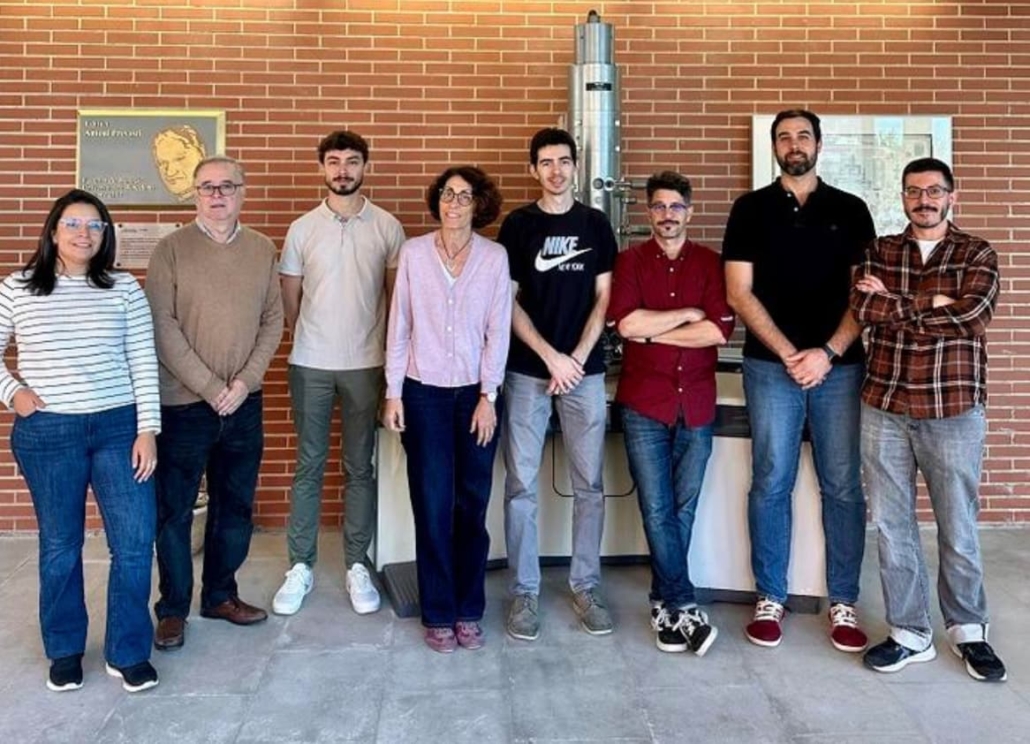Unlocking brown fat: cellular autophagy mechanism holds key to age-related metabolic decline
Researchers have identified chaperone-mediated autophagy as a critical regulator of brown adipose tissue thermogenic activity, revealing that age-related decline in this selective protein degradation pathway drives metabolic dysfunction. The findings, published in Science Advances, demonstrate that pharmacological activation of this mechanism can restore brown fat function in aged mice, opening therapeutic avenues for obesity and cardiovascular disease.

The research team. From left to right, Tania Quesada-López, Francesc Villarroya, Albert Blasco-Roset, Marta Giralt, Alberto Mestres-Arenas, Joan Villarroya, Aleix Gavaldà-Navarro and Rubén Cereijo. © UNIVERSITY OF BARCELONA
Cellular recycling system controls energy-burning fat tissue
Brown adipose tissue (BAT) represents a metabolically active organ capable of dissipating chemical energy as heat through uncoupled mitochondrial respiration. Unlike white adipose tissue, which primarily stores excess calories, BAT contributes substantially to whole-body energy homeostasis and metabolic health. However, this protective function declines progressively with age, contributing to increased susceptibility to obesity, type 2 diabetes, and cardiovascular complications.
The research team, led by Professor Joan Villarroya from the University of Barcelona’s Faculty of Biology and Institute of Biomedicine, has now elucidated a fundamental molecular mechanism underlying this age-related deterioration. Their work identifies chaperone-mediated autophagy (CMA) as an essential process for maintaining BAT thermogenic capacity.
Selective protein degradation drives thermogenic activation
Chaperone-mediated autophagy represents a type of selective lysosomal protein degradation in which substrate proteins are delivered directly across the lysosomal membrane rather than through vesicular intermediates. The process depends critically on the lysosome-associated membrane protein type 2A (LAMP2A), which serves as both substrate receptor and translocation channel.
The researchers discovered that thermogenic activation of BAT triggers marked upregulation of CMA activity. Using RNA sequencing analysis of interscapular BAT from mice maintained at thermoneutrality or exposed to cold, the team calculated a CMA score based on 19 genes involved in the pathway. “We found a significant increase in the CMA score of BAT in response to the thermogenic challenge,” the authors report in their paper, with concordant increases observed in white adipose tissue depots undergoing browning.
This induction appears to be cell-autonomous and directly responsive to adrenergic signalling. Treatment of cultured brown adipocytes with norepinephrine or cyclic AMP significantly increased both LAMP2A transcript and protein levels, demonstrating that CMA activation forms an integral component of the thermogenic gene expression programme.
Age-related CMA decline impairs metabolic function
The study revealed a pronounced decrease in CMA activity within BAT during ageing. Analysis of male mice at different life stages showed a marked reduction in the transcriptional CMA score between five and fifteen months of age, which was maintained at twenty-three months. Protein levels of LAMP2A, the rate-limiting CMA component, decreased concordantly across these ageing stages.
To investigate whether this decline contributes causally to BAT dysfunction, the researchers generated brown adipocytes with LAMP2A deficiency through lentiviral-driven short hairpin RNA knockdown. These cells exhibited substantially impaired thermogenic and metabolic activity, with reduced oxygen consumption, extracellular acidification, and glycerol release. Notably, secretion of brown adipokines including FGF21 and GDF15 was significantly diminished, whilst leptin secretion increased, indicating a shift towards a white adipose phenotype.
“The effects of thermogenic activation on LAMP2A expression were cell-autonomous, as evidenced by the significant induction of the LAMP2A transcript and a notable increase in LAMP2A protein levels in response to norepinephrine in brown adipocytes in culture,” the authors note.
Proteomic analysis reveals repressor protein accumulation
Comparative quantitative proteomics of control and LAMP2A-deficient brown adipocytes uncovered extensive changes in the cellular proteome. Loss of CMA resulted in altered abundance of 677 proteins under basal conditions, with pathway enrichment analysis identifying accumulation of proteins related to endoplasmic reticulum processing, actin cytoskeleton remodelling, and endolysosomal regulation. Conversely, proteins involved in mitochondrial organisation, thermogenesis, and lipid metabolism were reduced.
Crucially, the study identified accumulation of several established repressors of BAT thermogenic activity in LAMP2A-deficient cells, including platelet-derived growth factor receptor beta (PDGFRB) and adipocyte enhancer-binding protein 1 (AEBP1). Bioinformatic analysis predicted that transcription factors regulating genes encoding accumulated proteins included multiple known suppressors of brown adipocyte differentiation and thermogenic activation. More than eighty percent of these transcription factors contained KFERQ-like motifs indicating potential targeting by CMA.
Pharmacological intervention restores aged BAT function
The transcriptional nature of age-related CMA decline suggested potential therapeutic intervention. The researchers treated eighteen-month-old mice daily with CA77.1, a recently developed small molecule that activates CMA through transcriptional upregulation of pathway components. After five months of treatment, aged mice exhibited restored BAT activity with reduced lipid droplet size, increased LAMP2A and UCP1 protein levels, and enhanced expression of thermogenic and metabolic genes.
“In the study, ageing mice were treated with these drugs, and the adipose tissue was able to maintain its activity and improve metabolic function despite ageing,” Professor Villarroya explained.
In vivo validation using adeno-associated virus-mediated LAMP2A knockdown in BAT confirmed the pathway’s physiological importance. Mice with BAT-specific LAMP2A depletion showed increased fat accumulation, reduced oxygen consumption, elevated circulating triglycerides following cold exposure, and decreased secretion of thermogenic adipokines. Reciprocally, PDGFRB and AEBP1 protein levels increased, supporting a model wherein CMA activation during thermogenic stimulation selectively degrades repressor proteins to enable full BAT activation.
Therapeutic implications and future directions
The findings establish CMA as a critical regulatory node in BAT plasticity and suggest therapeutic potential for metabolic disease. “We are pursuing these lines of research both in experimental models and in initial studies in patients, in collaboration with several hospitals,” Professor Villarroya noted.
The research reveals that whilst macroautophagy is inhibited during thermogenic activation to preserve cellular machinery, CMA is markedly upregulated to enable selective removal of inhibitory proteins. This represents the first example of autonomous CMA responsiveness to thermogenic stimulus mediated directly through cAMP-dependent noradrenergic signalling rather than as a compensatory mechanism for macroautophagy failure.
The authors conclude that their work “highlights CMA as a key regulator of BAT plasticity and a promising therapeutic target for treating age-related metabolic disorders.”
Reference
Mestres-Arenas, A., Quesada-López, T., Blasco-Roset, A., et. al. (2025). Chaperone-mediated autophagy controls brown adipose tissue thermogenic activity. Science Advances, 11, eady0415. https://doi.org/10.1126/sciadv.ady0415

